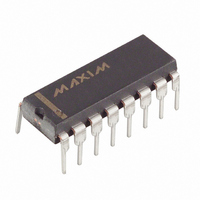DS1615 Maxim Integrated Products, DS1615 Datasheet - Page 11

DS1615
Manufacturer Part Number
DS1615
Description
IC RECORDER TEMP 5V 16-DIP
Manufacturer
Maxim Integrated Products
Type
Temperature Recorderr
Datasheet
1.DS1615.pdf
(24 pages)
Specifications of DS1615
Memory Size
32B
Time Format
HH:MM:SS (12/24 hr)
Date Format
YY-MM-DD-dd
Interface
3-Wire Serial
Voltage - Supply
4 V ~ 5.5 V
Operating Temperature
-40°C ~ 85°C
Mounting Type
Through Hole
Package / Case
16-DIP (0.300", 7.62mm)
Lead Free Status / RoHS Status
Contains lead / RoHS non-compliant
Available stocks
Company
Part Number
Manufacturer
Quantity
Price
Part Number:
DS1615S
Manufacturer:
MAXIM/美信
Quantity:
20 000
starts a datalog mission or polls the device for information, one or both of these pins will be pulsed four
times. Depending on the status of the device, both pins will be pulsed simultaneously or just one pin will
be pulsed at a time. Each pulse is 62.5 ms in duration and will start every half second. See Figures 8 and
9 for further details.
The
situations:
1. Datalog Mission Start When a datalog mission is first initiated, the
2. Request for Status of Data
Following a user request for the status of recorded temperature data, the
low pulses if the recorded temperature data is within the user defined limits (as set in the Low
Temperature Threshold and High Temperature Threshold registers). If the recorded temperature data
contains any readings that fall outside of these thresholds, the
the request comes after the mission has started (i.e., MIP = 1), but before the first temperature sample has
been recorded, the
with the
The DS1615 provides two methods for the user to request the status of the data. The first method is to
send the Specification Test command over the serial interface. The second method is by holding the
pin low for at least half a second after the datalogger has already been started.
CLOCK, CALENDAR, AND ALARM
The time and calendar information is accessed by reading/ writing the appropriate register bytes. Note
that some bits are set to zero. These bits will always read zero regardless of how they are written. The
contents of the time, calendar, and alarm registers are in the Binary-Coded Decimal (BCD) format.
The DS1615 can run in either 12-hour or 24-hour mode. Bit 6 of the hours register is defined as the 12-
or 24-hour mode select bit. When high, the 12-hour mode is selected. In the 12-hour mode, bit 5 is the
AM/PM bit with logic one being PM. In the 24-hour mode, bit 5 is the second 10-hour bit (20-23 hours).
The DS1615 also contains a time of day alarm. The alarm registers are located in registers 0007h to
000Ah. Bit 7 of each of the alarm registers are mask bits (see Table 2). When all of the mask bits are
logic 0, an alarm will occur once per week when the values stored in time-keeping registers 0000h to
0003h match the values stored in the time of day alarm registers. An alarm will be generated every day
when mask bit of the day alarm register is set to 1. An alarm will be generated every hour when the day
and hour alarm mask bits are set to 1. Similarly, an alarm will be generated every minute when the day,
hour, and minute alarm mask bits are set to 1. When day, hour, minute, and seconds alarm mask bits are
set to 1, an alarm will occur every second.
As a security measure to prevent unauthorized tampering, changing any value in the RTC and Control
registers (with the exception of the Status register) will stop a datalog mission and clear the Mission-in-
Progress (MIP) bit.
generate four low pulses simultaneously to give the end user a visual indication that a datalog mission
has begun.
INSPEC
OUTSPEC
and
OUTSPEC
pin.
INSPEC
and
pins are used to provide visual feedback to the end user in the following
OUTSPEC
pins will generate a total of four low pulses alternately, starting
11 of 24
OUTSPEC
pin will be pulsed four times. If
INSPEC
INSPEC
and
pin will generate four
OUTSPEC
pins will
ST












